Discovering the Polki Diamond Cut: A Detailed Exploration
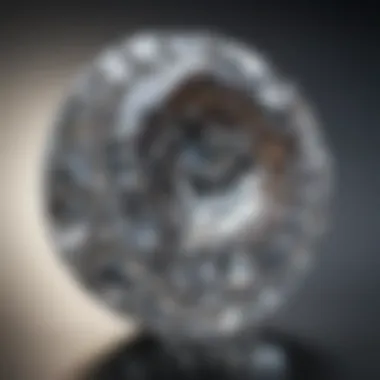
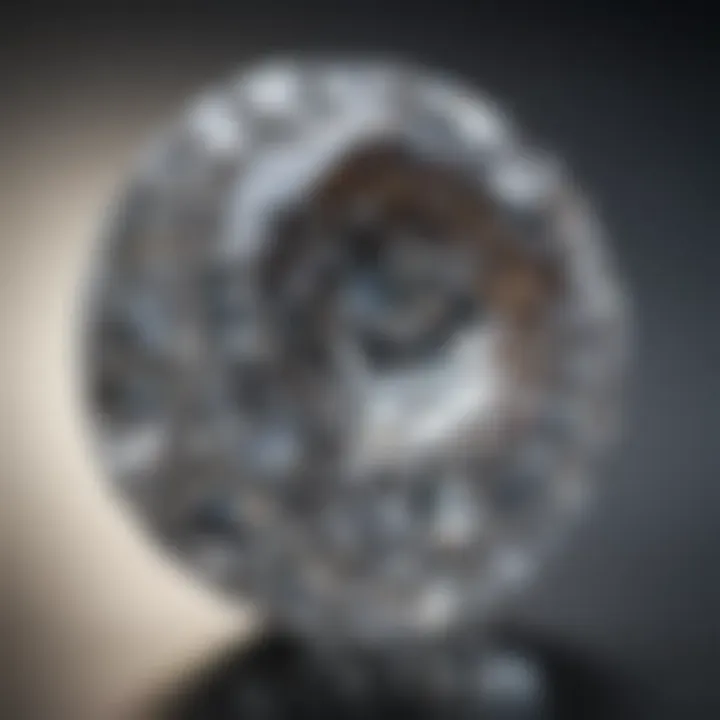
Gemstone Overview
Gemstones have captured human fascination for millennia, representing beauty, status, and the natural world's allure. Defining what precisely constitutes a gemstone helps ground our exploration into specialized cuts like Polki. Generally, gemstones can be described as precious or semi-precious stones that are either cut or shaped, commonly used in jewelry. They are often valued for their rarity, durability, and overall aesthetic quality. However, Polki diamonds distinguish themselves from traditional gemstones due to their unique characteristics.
Definition of Gemstones
A gemstone, at its core, can be any naturally occurring mineral or organic material that exhibits beauty and durability. This includes everything from colored stones like sapphires and rubies to clear transluscent stones like diamonds. Polki diamonds sit at an interesting juncture. They are not cut in the conventional sense; instead, they retain a rough beauty that embodies raw elegance. Their surface may appear unpolished at first glance, which contributes to their allure.
Classification of Gemstones
Gemstones can be broadly classified into two categories:
- Precious Stones: Traditionally, this includes diamonds, rubies, sapphires, and emeralds. They are considered the pinnacle in terms of value and luxury.
- Semi-Precious Stones: This category encompasses a broader variety of stones, such as amethyst, garnet, and aquamarine, which, while beautiful, are usually less expensive.
Polki diamonds, while technically classified as diamonds, gain their own standing, occupying a middle ground between these two classifications. This uniqueness opens up avenues we shall delve into further.
Historical Significance
Examining Polki diamonds leads us to their roots. They are not merely beautiful; they carry stories, traditions, and artwork that span generations and cultures. The history of gemstones, including Polki diamonds, is intertwined with the rise and fall of civilizations, making them more than mere adornments.
Origins of Gemstone Use
The narrative surrounding the use of gemstones is rich and multi-faceted. Historical accounts trace back to ancient societies where gemstones were believed to possess mystical powers. From the pharaohs of Egypt to Indian royalty, the allure of gemstones—especially diamonds—was insatiable. Polki diamonds originated in India and were popularized during the Mughal Empire. Their raw, uncut design differed vastly from the polished diamonds dominating today's market, presenting a style that was steeped in tradition and culture.
Cultural Insights: Gemstones in Ancient Civilizations
Ancient civilizations had a complex relationship with gemstones, often attributing spiritual significance to them. The use of gemstones, including Polki diamonds, can be observed in various forms such as:
- Symbols of Power: Kings and queens adorned themselves with intricate jewelry to signify their status.
- Religious Artifacts: Many ancient civilizations, including Hindus and Egyptians, crafted religious objects using gemstones, believing they could connect to the divine.
- Trade Goods: Gemstones became essential in trade routes, boosting economies and establishing connections between diverse cultures.
The cultural legacy of Polki diamonds reflects not just indigenous craftsmanship but also a blend of practical use and spiritual significance that resonates even today.
"The elegance of Polki diamonds lies in their raw form, reminding us of a time when craftsmanship was an art deeply entwined with culture."
As we transition from understanding the basics and historical aspects, it lays the groundwork for a deeper exploration of how these diamonds have evolved and how they fit into modern jewelry design.
Foreword to Polki Diamonds
Polki diamonds hold a special place in the realm of gemstones, serving as a bridge between traditional craftsmanship and contemporary allure. Known primarily for their uncut nature, these diamonds offer a unique aesthetic that stands out amongst other diamond varieties. For gemstone enthusiasts and collectors, understanding Polki diamonds is vital, as it reveals a deeper appreciation for the artistry and cultural significance embedded within each piece.
The appeal of Polki diamonds goes beyond their visual charm; they are steeped in history and rich with cultural heritage. By exploring their definition and backstory, readers can engage with the nuances that distinguish these diamonds in a bustling jewelry market. In doing so, the article will underscore the significance of Polki diamonds not just as accessories, but as pieces that carry stories of craftsmanship and societal value.
Definition and Background
Polki diamonds are uncut diamonds, distinguished by their raw and rustic look. Unlike conventional diamonds that undergo intricate cutting processes to maximize sparkle and brilliance, Polki diamonds retain their original form, revealing their organic beauty. This authenticity reflects an age-old method distinctive to India and allows these diamonds to maintain their unique charm. Furthermore, their shapes are irregular and often inspired by nature, contributing to their distinctive aesthetic that many find irresistible.
Historical Context
Origins in India
The origins of Polki diamonds trace back to India, particularly during a time when handcrafted artistry was at its peak. Polki diamonds emerged from the need for gemstones that could be used in royal ornaments, often fashioned for the Mughal emperors and their courts. The prevailing characteristic of Polki diamonds was their raw form. This lack of cutting reflects a desire to showcase the natural beauty of the stone rather than conforming to Western ideals of perfected brilliance. Such origins not only contribute to their overarching narrative but also enhance their status among collectors and enthusiasts today.
A significant advantage of Polki diamonds lies in their ability to connect modern jewelry makers with a historical context that values authenticity over perfection. One unique feature of these stones is the visible inclusions often seen within them. While many would consider these marks of imperfections, they are perceived as a testament to each diamond's individual journey.
Cultural Significance in Mughal Era
The cultural significance of Polki diamonds during the Mughal era can't be overstated. They were often associated with royalty, serving as symbols of wealth and power. The grandeur of Mughal jewelry, meticulously crafted with these diamonds, represented not just luxury but also a continuation of tradition. The intricate designs often intertwined with cultural motifs made Polki jewelry spectacular and timeless.
A key characteristic that sets Polki diamonds apart in this context is their representation of a bygone era where craftsmanship was paramount. This historical footprint adds layers of value and desirability in the contemporary market. Each piece encapsulates a narrative of Indian regal history, offering collectors and jewelry enthusiasts a chance to possess not just a piece of jewelry, but a slice of history itself.
As we dive deeper into the world of Polki diamonds, it's crucial to recognize their importance. They symbolize artistry born from tradition and evoke an emotional connection that modern cuts often overlook. Understanding this cultural backdrop allows us to appreciate the enduring appeal of Polki diamonds.
The Art of Polki Diamond Cutting
Polki diamond cutting represents a fusion of artistry and tradition, distinguishing itself in the broader world of jewelry. Its process aims to enhance the diamond's natural flaws and beauty rather than conceal them, offering a juxtaposition between raw elegance and refined craftsmanship. This section examines the intricate methods and unique traits that characterize Polki cutting, showcasing why it remains a celebrated choice in both traditional and modern jewelry.
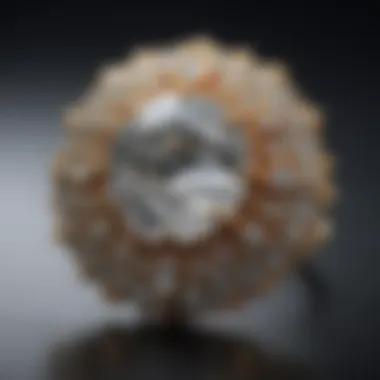
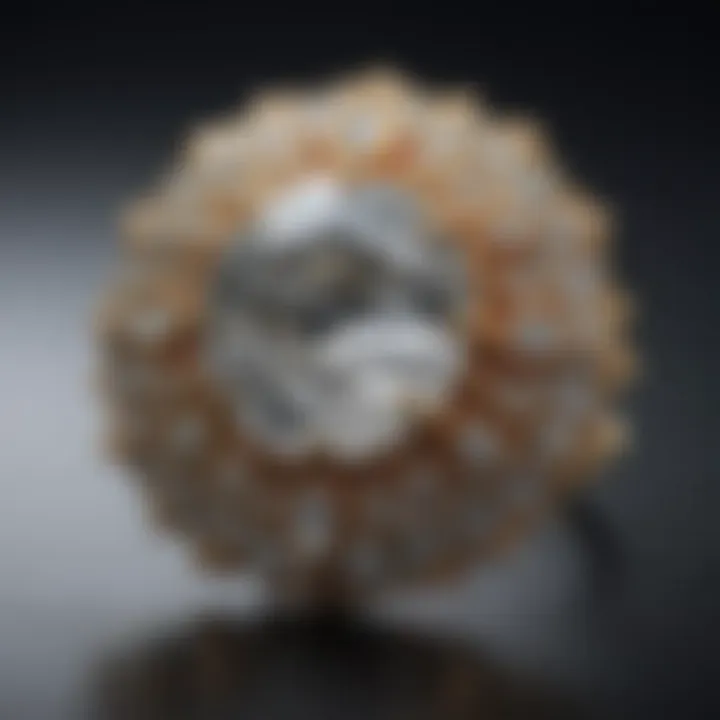
Craftsmanship Techniques
Traditional Methods
Traditionally, the art of Polki diamond cutting is rooted in centuries-old techniques that hark back to the artisans of India. These methods are not just skills passed down through generations but a cultural narrative reflecting the heritage of Indian craftsmanship. The key characteristic of traditional Polki cutting lies in its hand-tooling methods, where artisans use rudimentary tools to shape and polish each diamond by hand. This uniqueness contributes significantly to the gem's overall texture and appearance.
The benefit of employing such traditional methods is the ability to maintain the diamond's original form—flaws and all—making each piece of jewelry a one-of-a-kind representation of the natural stone. However, this process can be labor-intensive and time-consuming, often resulting in higher costs. Nevertheless, the charm of a Polki diamond cut lies in these very imperfections that speak to its authenticity.
Modern Adaptations
As the jewelry industry evolves, so too does the art of Polki diamond cutting. Modern adaptations have introduced advanced tools and techniques that streamline the cutting process without sacrificing the diamond's unique aesthetic. These adaptations often involve the use of laser cutting technology, which enables precise shaping and enhanced finishes that were nearly impossible to achieve by hand alone.
The versatility of modern methods makes them a popular choice among contemporary jewelers who aim to cater to a broader audience. The main advantage is improved efficiency, allowing designers to create stunning pieces more rapidly. Nonetheless, one must be cautious—the use of high-tech tools can sometimes overshadow the intrinsic beauty of the uncut surface, which is a vital aspect of Polki diamonds that collectors and enthusiasts treasure.
Unique Characteristics
Uncut Surface
The uncut surface of Polki diamonds is a distinctive aspect that sets them apart from other cuts. This natural finish retains the integrity of the rough diamond, providing a raw, organic feel that captures light uniquely. The uncut appearance often draws admiration, as it reflects the stone's authenticity and narrative.
This characteristic is particularly beneficial for those who appreciate natural jewelry. The lack of a faceted finish means each diamond exhibits a soft glow rather than the sharp brilliance found in conventional cuts. While this can be a disadvantage for some who prefer the sparkle, it is precisely this subdued elegance that has led many to embrace the charm of Polki diamonds.
Natural Inclusion Features
Natural inclusions found in Polki diamonds are more than mere imperfections; they are storytelling tools that illustrate the diamond's history. These inclusions, often likened to fingerprints, contribute to the gem's identity and allure. In this sense, they embody the essence of natural gems, celebrating their imperfections rather than hiding them.
This feature is widely seen as a beneficial trait, especially in the context of artistic jewelry. While some may view these inclusions as flaws, many enthusiasts perceive them as markers of uniqueness and authenticity. However, these natural traits can also affect the market value of the diamond, which might be lower than a flaw-free stone. Despite this, the niche for Polki diamonds continues to grow, underscoring a collective move towards valuing character over flawlessness in jewelry.
Comparative Analysis of Diamond Cuts
When diving into the intricacies of diamond aesthetics and selections, a comparative analysis of diamond cuts becomes vital. The diverse methods of cutting diamonds have significant implications, not only for their visual appeal but also for their cultural significance and marketplace value. Understanding the differences between Polki diamonds and conventional cuts sheds light on their unique identities and the resulting impact on consumer choices. This analysis assists enthusiasts and collectors alike in navigating the often overwhelming landscape of diamond options by contrasting the particular attributes of each cut. It explores how craftsmanship informs allure and desirability, ultimately affecting purchasing decisions and sentimental value.
Polki vs. Conventional Cuts
Brilliance and Sparkle
A key point of differentiation between Polki diamonds and the more common diamond cuts is found in their brilliance and sparkle. Conventional cuts—think round or princess—are often celebrated for their exceptional light reflection, resulting in a dazzling play of colors. The faceted surfaces of these cuts allow for maximum light entry, creating a sparkle that can make jaws drop.
In contrast, Polki diamonds possess a unique charm that comes from their uncut surfaces. While they don't shine in the same way, their natural inclusions and rough edges present a different kind of beauty. This gives Polki diamonds an earthy elegance that garners admiration. This difference also speaks to a greater aesthetic; many individuals prefer the subtlety of Polki over the flashy nature of standard cuts. The beauty of Polki lies not in conventional sparkle but in the worn, vintage feel that transports viewers back in time.
Moreover, as the trend of embracing raw and natural aesthetics grows, Polki cuts are slowly but surely cementing their place in the jewelry scene.
Cost and Availability
When it comes to cost and availability, the differences between Polki diamonds and conventional cuts can be striking. Generally, polished diamonds hold a premium due to their demand and thorough cutting processes, which often makes them more expensive than their Polki counterparts. The cost associated with creating a faceted diamond is high because of labor, technology, and precision needed to achieve that brilliant finish. For consumers looking for quality at a more approachable price, Polki diamonds become a logical choice.
On the other side of the coin, the availability of Polki diamonds can sometimes be marked by scarcity. Authentic Polki diamonds are usually sourced from artisanal mines and are not mass-produced like their conventional siblings. They require skilled artisans who understand the craftsmanship in retaining the jewel's original shape while ensuring its integrity. Consequently, buyers may find that while Polki diamonds come at a friendly price point, the rarity of designs can introduce fluctuations in market value.
Ultimately, while you might snag a Polki piece for a fraction of what it costs for a well-cut diamond, the journey toward finding authentic pieces often requires thorough exploration and the right connections.
Cultural Perceptions
Cultural perceptions of diamond cuts carry varying weights in the jewelry world. In some cultures, Polki diamonds are considered a representation of heritage and tradition, depicting a sense of royal history that cannot be replicated. They evoke a connection to previous artisans and craftsmanship that spans generations, making them a highly sought-after choice among jewelry designers.
Conventional cuts, however, carry their own cultural baggage. In modern society, they are often equated with luxury and status, frequently associated with engagement rings and high-end jewelry pieces. This encapsulation of societal expectations places them firmly within the realm of contemporary luxury.
Interestingly, as global conversations surrounding sustainability and ethical adornment grow more robust, Polki diamonds are emerging as favored options for individuals who value not only beauty but also the stories behind these handcrafted stones. In turn, this is shifting perceptions towards incorporating the wealth of cultural significance that comes with choosing Polki.
Polki Diamonds in Contemporary Jewelry
Polki diamonds have danced elegantly into the spotlight of contemporary jewelry design. Their recognition extends beyond mere ornamentation; they are now seen as a bridge connecting rich tradition with modern flair. When discussing Polki diamonds, it’s essential to recognize their role in the dynamic fashion landscape today, reflecting cultural identities and personal stories.
Current Trends
Integration in Fashion

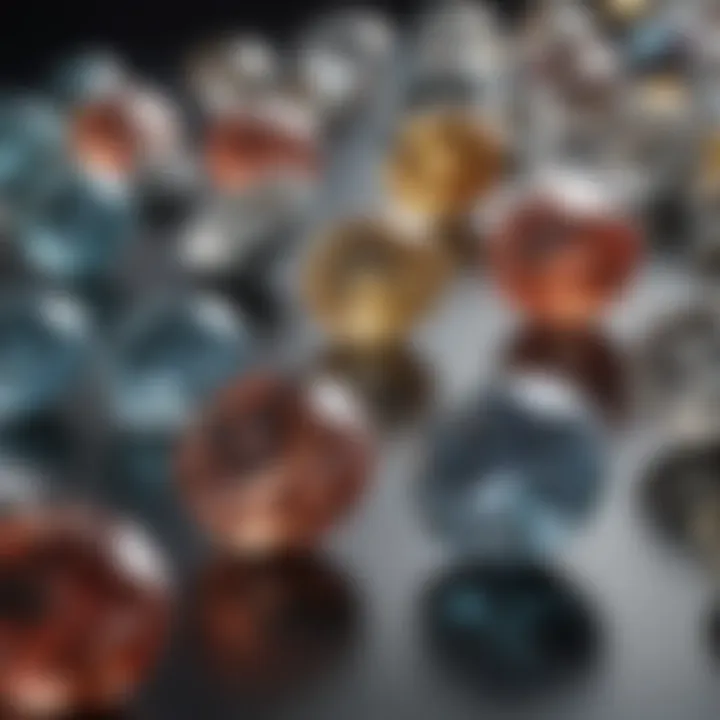
The integration of Polki diamonds into modern fashion has been nothing short of revolutionary. Unlike conventional diamonds, Polki diamonds, with their raw and uncut edges, bring a distinctive character to jewelry pieces. This characteristic not only amplifies their attraction but also contributes to their niche in the ever-evolving fashion scene.
One of the standout aspects here is the adaptability of Polki diamonds. Fashion designers are increasingly incorporating these stones into a variety of styles—from traditional to avant-garde. This versatility allows them to fit perfectly into both casual and formal attire, making Polki jewelry a versatile choice for many occasions. For instance, wearing a bold Polki necklace with a simple dress can instantly elevate an outfit by lending a vintage touch without overpowering the wearer's style.
However, while they are increasingly popular, their integration does come with the challenge of maintenance. Being more delicate than their cut counterparts, Polki pieces require careful handling, which can be a concern for some fashion-forward individuals running about their daily lives.
Popularity among Celebrities
The allure of Polki diamonds is amplified in the celebrity stratosphere. Various stars have donned these stunning pieces on the red carpet, making them symbols of high-end and culturally rich fashion. For instance, prominent figures may opt for Polki bracelets or rings that speak volumes about heritage while also making a bold fashion statement.
The celebrity endorsement effectively propels Polki diamonds into mainstream awareness. People are drawn to these pieces not just for their beauty but because of the cultural narrative they carry. Wearing Polki jewelry allows one to appear trendy while still honoring ancient traditions. However, the catch lies in accessibility; as more celebrities flaunt these unique pieces, the demand skyrockets, often leading to increased prices and potential scarcity for regular consumers.
Jewelry Styles Featuring Polki Diamonds
Earrings and Necklaces
In the arena of earrings and necklaces, Polki diamonds shine brightly, quite literally. Pieces adorned with these gems are increasingly favored for their ability to offer a distinctive touch that standard diamonds often lack.
The key characteristic of using Polki diamonds in earrings and necklaces lies in their organic sparkle. Unlike traditional cuts that focus on creating brilliance, the beauty of Polki lies in its raw, unrefined edges, which exude a sense of authenticity. This trait makes these styles particularly appealing for festivals and weddings, as they resonate well with traditional attire.
A major advantage is their ability to complement a spectrum of fabrics and styles—from regal silks to modern silhouettes—however, that allure can sometimes come with a price. Due to their unique cut and the craftsmanship involved, Polki pieces can be on the pricier side compared to more mainstream alternatives.
Bridal Collections
There’s something truly enchanting about Polki diamonds when it comes to bridal collections. They resonate deeply with the sentiments of love and commitment, often seen gracing the necks and ears of brides on their big day. The intrinsic essence of these gems tells a story that mirrors the age-old traditions of many cultures, especially in Indian weddings.
One of the main reasons they are increasingly a choice for bridal collections is the cultural significance that comes with them. Incorporating Polki jewelry can enhance tradition, making the attire more meaningful. Their unique sparkle blends seamlessly with intricate bridal wear, creating timeless looks cherished throughout generations.
Nonetheless, brides must consider practicality. Since Polki pieces can be more fragile, the bride might need to be cautious, especially during lively celebrations. But the trade-off, where striking beauty meets emotional resonance, certainly makes them worth the extra care.
"Polki diamonds are a dance of tradition and elegance, stepping into the modern world without losing their heritage."
Investment Value of Polki Diamonds
When we talk about investing in gems, Polki diamonds hold a unique place. They are not just stones; they carry a rich narrative of history and art. Understanding the investment aspect of Polki diamonds is vital. This section dives into market trends and factors influencing their value, painting a picture of why they are worth considering.
Market Trends
Collectibility and Demand
Polki diamonds are capturing the imagination of collectors and investors alike. The distinct charm that comes with these uncut diamonds is what makes them highly collectible. Many enthusiasts are drawn to the romantic allure of Polki. Unlike traditional cut diamonds, these stones are steeped in history, and that plays a significant role in their appeal.
The unique aspect of Polki diamonds is that they are often associated with cultural heritage. For many, owning a piece of jewelry that features Polki means possessing a fragment of Indian traditions. This sentimental value elevates their collectibility, leading to an increase in demand in niche markets. It's not just about the sparkle; it’s about owning something that's part of a larger story. As demand rises, so does the value, making it an appealing choice for investors.
- Unique Features of Collectibility:
- Cultural heritage connection.
- Increasing interest from collectors.
- Rarity enhances desirability.
Yet, potential buyers should keep in mind that collectibility comes with its challenges. The market can fluctuate based on global interests and trends in the jewelry world, which may affect investment decisions.
Prospective Returns
Prospective returns on Polki diamonds can be quite attractive, especially in a market where traditional diamond cuts have seen increasing prices. Given their rising popularity, those investing in Polki diamonds are often optimistic about future gains. Investors frequently note that Polki’s distinctive features can lead to substantial appreciation over time.
One key characteristic that enhances prospective returns is the limited supply. As Polki diamonds are handcrafted and can be rarer than conventional cuts, their value tends to increase with time. Collectors often find themselves in bidding wars for especially unique pieces, driving prices up even further.
- Unique Features of Prospective Returns:
- Limited supply drives value.
- Collector interest can spur price increases.
However, while the potential for returns exists, nothing is guaranteed. Markets can shift, and trends can change, which could impact the resale value of these diamonds.
Factors Influencing Value
The value of Polki diamonds is not simply a matter of market trends. Various factors play a crucial role in determining how valuable these gemstones are.

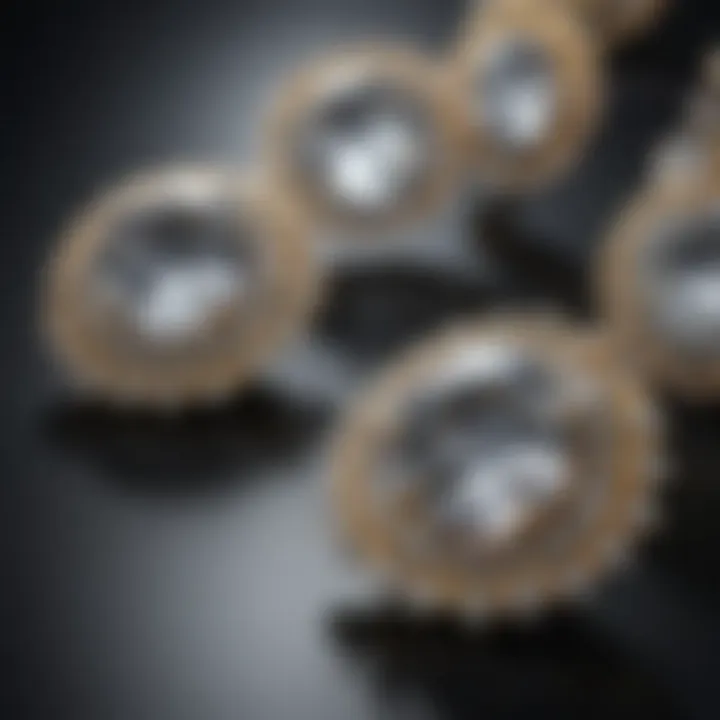
Quality of Craftsmanship
One major factor influencing the value of Polki diamonds is the quality of craftsmanship. The artisanal process behind creating Polki jewelry is intricate. Each piece tends to be unique due to the manual labor involved in their production. High-quality craftsmanship can mean the difference between a generic piece and a true work of art.
A prominent characteristic of fine craftsmanship is the attention to detail. A well-made Polki piece showcases not just the diamond itself, but also the artistry behind it. Ultimately, pieces with superior craftsmanship tend to have a higher value in the market.
- Unique Features of Quality Craftsmanship:
- Detailed artisanal work.
- Individual character of each piece.
Investors should be aware that not all Polki diamonds are crafted with the same level of skill. This risk means that some investments could vary widely in value.
Rarity and Authenticity
Rarity and authenticity stand tall among the factors affecting the value of Polki diamonds. Genuine Polki diamonds are often hard to come by, especially in today's market where imitation goods are more prevalent. Authenticity can be verified through certifications from reputable sources, which can add to overall value.
Collectors often value rare finds that speak to their unique backstory and craftsmanship - which is not something you find every day. This rarity is a powerful motivator for investment.
- Unique Features of Rarity and Authenticity:
- Genuine pieces are harder to find.
- Authentication increases value.
However, the market can be unpredictable, and buyers may need to conduct thorough research to ensure the authenticity of what they're purchasing.
"Investing in Polki diamonds requires a blend of passion and acumen; understanding their market and uniqueness is essential for any serious collector."
Adopting a diligent approach towards understanding market trends, factors influencing value, and the risks involved will pave the way for informed decisions in the world of Polki diamond investments.
Caring for Polki Diamonds
Caring for Polki diamonds is essential not just for maintaining their beauty but also for preserving their value over time. Unlike conventional diamonds, Polki diamonds are uncut, meaning their surfaces are rough and include natural inclusions. This characteristic requires a different approach to cleaning and storage. Furthermore, how one cares for these jewels can greatly influence their longevity and overall appearance. Keeping Polki diamonds in pristine condition reflects the owner's appreciation for their historical and cultural significance, making care practices vital for both personal enjoyment and potential resale value.
Cleaning Techniques
Gentle Cleaning Methods
When it comes to cleaning Polki diamonds, gentle methods are paramount. The key characteristic of gentle cleaning methods is their non-abrasive nature, which ensures that the uncut surface of the diamond is not scratched or damaged. A simple mixture of lukewarm water and mild soap is often the go-to solution. When using this method, it's recommended to apply the cleaning solution with a soft cloth or a baby toothbrush designed for delicate items. This approach minimizes risk while effectively removing dirt accumulation.
The unique feature of gentle cleaning methods is their simplicity and accessibility. They communicate a sense of care and attention that resonates with both the jewelry piece and its owner. However, this method has some disadvantages; it might be less effective against tough stains or grime. Therefore, taking extra care and being patient during the cleaning process is crucial.
Avoiding Damage
Avoiding damage is another critical consideration when it comes to Polki diamonds. These gemstones are inherently more fragile than their cut counterparts, so taking preventive measures can save a lot of heartache. One of the best practices involves removing jewelry before engaging in activities that could expose it to harsh chemicals or physical stress, such as exercising, cleaning, or applying beauty products.
The essence of avoiding damage lies in the conscientious effort to uphold the integrity of the diamond. This approach has a major benefit: it extends the lifespan of the jewelry, ensuring that it remains appealing for years to come. However, there's a flip side; being overly cautious can sometimes lead to limitations on when and where to wear these beautiful gems.
Storage Recommendations
Optimal Conditions
Storing Polki diamonds in optimal conditions is fundamental to protecting their allure. The best environment features a cool, dry place devoid of direct sunlight and humidity. Cloth pouches or dedicated jewelry boxes lined with soft fabric are suitable choices for protecting these gems from scratches and dust. The key characteristic of optimal conditions is the way they contribute to maintaining the diamond's natural beauty and preserving its value over time.
By choosing the right storage solution, one can prevent the inevitable wear and tear that comes with exposure to the elements. However, there is a downside; maintaining these optimal conditions may require proactive management and awareness of one's environment.
Preventing Scratches
Preventing scratches is vital for Polki diamonds since their rough surfaces are more susceptible to marks. One effective strategy is to store them separately from other pieces to eliminate the risk of contact with harder gemstones or metal parts. This practice not only prevents scratches but also preserves the aesthetics of the Polki diamond, ensuring that its unique qualities remain unblemished.
A hallmark of preventing scratches is the awareness it cultivates – the act itself becomes an avenue for the owner to appreciate their jewelry more deeply. In this way, it plays a dual role in protection and engagement. On the other hand, being overly fastidious could lead to excessive caution in handling the jewelry, potentially detracting from moments of enjoyment.
Culmination
Diving into the world of Polki diamonds provides a captivating glimpse into a tradition that intertwines beauty, craftsmanship, and cultural heritage. The significance of Polki diamonds goes beyond their aesthetic appeal; they carry a rich history, embodying the craftsmanship that transforms raw gems into exquisite jewelry pieces. Understanding the nuances of these uncut diamonds enhances appreciation not only for their unique characteristics but also for the artisans who dedicate their lives to this intricate process.
The Enduring Allure of Polki Diamonds
Polki diamonds are not just another gem representing luxury; they evoke a sense of history that sticks with the wearer. Their rough surfaces and enchanting inclusions tell a story that polished diamonds simply cannot. This article highlights several elements that contribute to their lasting charm:
- Cultural Resonance: Dating back to the Mughal era, Polki diamonds played a significant role in royal adornments. Their historical significance gives them an aura of nostalgia that is unmatched.
- Artisanal Craftsmanship: The skills needed to shape and set Polki diamonds often remind one of the fine balance between tradition and modernity. Craftsmen use techniques passed down through generations, making each piece unique.
- Versatility in Design: Polki diamonds harmonize well with various styles, whether it's traditional bridal jewelry or contemporary fashion pieces. This versatility ensures they remain relevant in both classical and modern wardrobes.
- Investment Value: With the increasing demand for ethically-sourced stones, Polki diamonds are becoming more desirable for collectors. Their rarity and unique charm have captured the interest of investors looking for something different.
In summary, the enduring allure of Polki diamonds lies in their multifaceted nature, combining tradition, modernity, and a sprinkle of elegance. Whether one is an avid collector or just an admirer of beauty, understanding the richness of Polki diamonds opens doors to a timeless appreciation. This article serves as an ode to the artistry and significance imbued in every uncut diamond, inviting readers to recognize their worth beyond mere materials.



